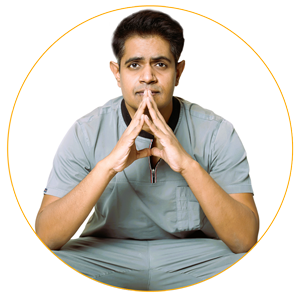Vaginal Fistula & Anal Incontinence
Plastic surgeons come into picture in treatment for vaginal fistula and anal incontinence when all the other options for healing the area and the fistula.

Plastic surgeons come into picture in treatment for vaginal fistula and anal incontinence when all the other options for healing the area and the fistula and anal sphincter correction are exhausted by the surgeons, gynecologists and the urologist
Vaginal Fistula
A vaginal fistula is an unusual opening that connects vagina to another organ in females like rectum, bladder, urethra, ureter and small & large intestine. We would like to limit our discussion for management of fistula connecting vagina with the rectum or the bladder
- Rectum, the lower part of large intestine-rectovaginal fistula
- Bladder - vesicovaginal fistula
Out of all these above-mentioned locations of fistula, Plastic surgeons contribute in the management ofrectum or difficult recurrent bladder fistulae. Fistulas at the higher locations within the abdomen region are managed by Urologists and general surgeons.
The main reason is tissue damage because of :
- Childbirth/ labour,
- Any Abdominal surgery (hysterectomy or caesarean section)
- Pelvic, cervical, or colon cancer
- Radiation treatment
- Bowel disease like Crohn's or diverticulitis
- Infection (including after an episiotomy or a tear while labour)
- Traumatic injury, such as from a car accident
Symptoms of Vaginal Fistula
Vaginal fistulas arevery embarrassing to women when they leak and cause bad smells.
- If there is an opening between vagina and bladder, urine will constantly leak from the bladder into vagina. This can make unable to control urination (incontinent).
- If there is an opening between vagina and rectum, faecal matter or gas can constantly leak from the rectum into the vagina and this can make the patient unable to control the bowel movements also
- Also, genital area may get infected or sore, and you can have pain during intercourse.
- Vaginal or urinary tract infections that keep coming back
- Hygiene problems
Diagnosis of Vaginal Fistula
A pelvic exam is a must and details about medical and surgical history to see any risk factors for fistulas, like a recent surgery, infection, or radiation.
Few investigations are advised to confirm the diagnosis of fistula, its path, numbers and extent:
- Fistulogram - This is an X-ray image of the fistula. It can show number of fistulas and if other pelvic organs may be involved.
- Dye test(for bladder fistulae) - Bladder is filled with a dye solution. The patient is asked to cough or bear down. If there is a vaginal fistula, the dye will leak into the vagina.
- Cystoscopy(for bladder fistulae) - A thin device called a cystoscope is used to look inside bladder and urethra for signs of damage and opening of fistula.
- Flexible sigmoidoscopy(for rectum fistulae) - Anal and rectal areais examined with a sigmoidoscope (a thin, flexible tube with a tiny video camera at the tip).
- Pelvic MRI(for rectum fistulae) - Detailed pictures of rectum and vagina are done to help show the details of a rectovaginal fistula.
Treatment of Vaginal Fistula
- Small vaginal fistulas may heal on their own. If it's a bladder fistula, a small tube called a catheter is put into your bladder to drain the urine and give the fistula time to heal by itself. An antibiotic to treat infection caused by the fistula is also started.
- Most people who have larger fistulas need surgery. What kind of surgery you get depends on the type of fistula and where it is? It could be laparoscopic or it could be abdominal surgery done by gynecologists, general surgeons and urologist.
- For failed fistula surgery/recurrent fistula - connecting vagina with the Bladder or rectum, addition of tissue from another place of the body can seal the fistula. This procedure is usually done by plastic surgeons.
The margins of the fistula and its surrounding area is inflamed and scarred and does not hold sutures good and tightand thus repairs are liable to give up and form fistula again. Dr Amit Agarwal bring in healthy tissues from the thigh in form of a muscle and well vascularised pedicled flap to inset between the rectum and the vagina so that the area can heal properly.
The surgery is usually done in lithotomy position only usually completed within an hour or 2 hours.
Anal Incontinence
Anal incontinence is one of the most psychologically and socially embarrassing conditions in men and women lead in to social isolation, loss of self-esteem, self-confidence and depression.
Anal incontinence is the inability to voluntarily exert control and expel the passage of bowel contents at a socially acceptable location and time in both and women over the age of four years.
Anal incontinence is thought to be very common, but much under reported due to embarrassment.
- Prevalence of 2.2% in the general population.
- It affects people of all ages but is more common in older adults (but it should not be considered a normal part of ageing).
- Females are more likely to develop it than males (63% of those with anal incontinence over thirty are females)
Causes of Anal incontinence
- Many surgeries in the perineal and anal region are associated with this possible complication. Examples are after surgery for fissures, piles, fistula and cancer surgery and anal dilatation.
- Trauma during childbirth, complete perineal tear to be the most common cause.
- Injury to the area after Trauma, accidents
Diagnosis of Anal incontinence
The diagnosis was made with a –
- Thorough history including detailed questioning about symptoms, bowel habits, diet, medication and other medical problems.
- Digital rectal examination is done routinely to assess resting pressure and voluntary contraction (maximum squeeze) of the sphincter. If the examining finger met little resistance and the anus felt patulous, significant sphincter dysfunction is diagnosed. The patient is asked to tighten the sphincter around the examining finger to ascertain how much voluntary control was possible.
- Anorectal manometry records of pressure exerted by the anal sphincters and puborectalis during rest and during contraction before and after defecation.
Treatment of Anal incontinence
After routine investigations, the patient is usually posted for surgery and in lithotomy position, the perineal tear or anal sphincter is repairedif the margin ofthe cut muscle sphincter are visible and the area of damage is limitedand not widespread with less scarring. This repair is usually done by gynaecologists or general surgeons.
Plastic surgeons contribute in the management of anal incontinence when initial surgical management has failed or the area of scar and damage is too extensive to be repaired with the help of local tissues.Management of anal incontinence is usually achieved with the help of gracilis sling operation around the anal sphincter.
The muscle does not seem to act as a dynamic sphincter but does offer passive resistance to outflow of bowel contents. The muscle acts as an inert sling with a success rate between 60 to 90 percent.
The surgery is usually done under regional anaesthesia and in lithotomy position. Dr Amit Agarwal usesgracilis muscle from thethigh for encircling the anal sphincterwhich is harvested by a longitudinal incision given on the medial aspect of thigh. The tendon of the muscle is brought into the perianal tunnel at the sides and back of the anorectal region. The muscle is wrapped around the anal canal, and then forcibly drawn forwards again to be reattached by nylon 1/0 stitches to periosteum of lower surface of ischial tuberosity bone. Digital examination after the sling is created confirms that a finger could be inserted easily and had the sensation of being firmly gripped.
Post-surgery, patients go through a period of training with exercises to learn to voluntarily contract and relax the muscle. The muscle contracts with abduction of the thigh and can be made to relax by assuming the squatting position to avoid abduction of the leg.
Know your surgeon better

Best plastic surgeon, Dr. Amit Agarwal is an American Board Certified, extensively trained, and best Plastic & Aesthetic surgeon in Lucknow. He is the Chief Plastic Surgeon heading the Department of Plastic, Microvascular, and Craniofacial surgery at Vivekananda Polyclinic and Institute of Medical Sciences, Lucknow, U.P, India. He maintains a busy practice at Avadh and Nishat Hospital and his own center - Kayakriti Plastic Surgery & Dental Center. He was formerly a Consultant in the Department of Plastic Surgery and Burns at the prestigious SGPGI, Lucknow.
MS, DNB (General Surgery) MCh, DNB (Plastic Surgery),
MNAMS, FACS, FICS, FRCS (Edinburgh, UK)
His Credentials
Three pillars of kayakriti
Privacy
We believe your experience with us should be comfortable and hassle-free to make it one of your best lifetime experiences for yours. We, here at the clinic, take full precautions to maintain your privacy in any manner. We also provide a staff who will receive you from the gate and take you to the chamber directly if you demand.
Trust
Our Surgeon is highly qualified and internationally certified with a team of skilled staff to perform any surgical or non-surgical treatment on your body.
Safety
When you plan to undergo any surgery you should always keep in mind that it's your body and it's a surgery. We, here always keep your safety a priority and will never recommend you to undergo any such procedure which is not safe for you. We also provide you with a detailed description of the complications which may occur after the surgery during the consultation as it's a surgical procedure so there may be some complications depending on the way your body reacts.
Kayakriti in news



Frequently Asked Questions
If you have flat or small breast and you want to improve your breast and hip contour ratio then you are a good candidate for it. The answer will be best provided after the first consultation with Dr Amit Agarwal.
Acute pain will be there for almost a week which gradually reduces and there will be soreness and swelling which may take up to 3 weeks to subside.
You can join your work and daily routines after a week of the procedure and can start exercising after 3 weeks of it.
Yes, you have to wear it round the clock unless we suggest you to remove it.
This surgery does not affect the ducts or the areas of the breast involved in milk production. Thus, it does not affect the breast feeding.
This surgery does not affect the ducts or the areas of the breast involved in milk production. Thus, it does not affect the breast feeding.












Kayakriti Plastic Surgery & Dental Center
D-43, Near Punjab National Bank, Rajajipuram, Lucknow, Uttar Pradesh - 226017, India
Phone No. +919695940009, +919695940006
Map Location





























Social Media Presence